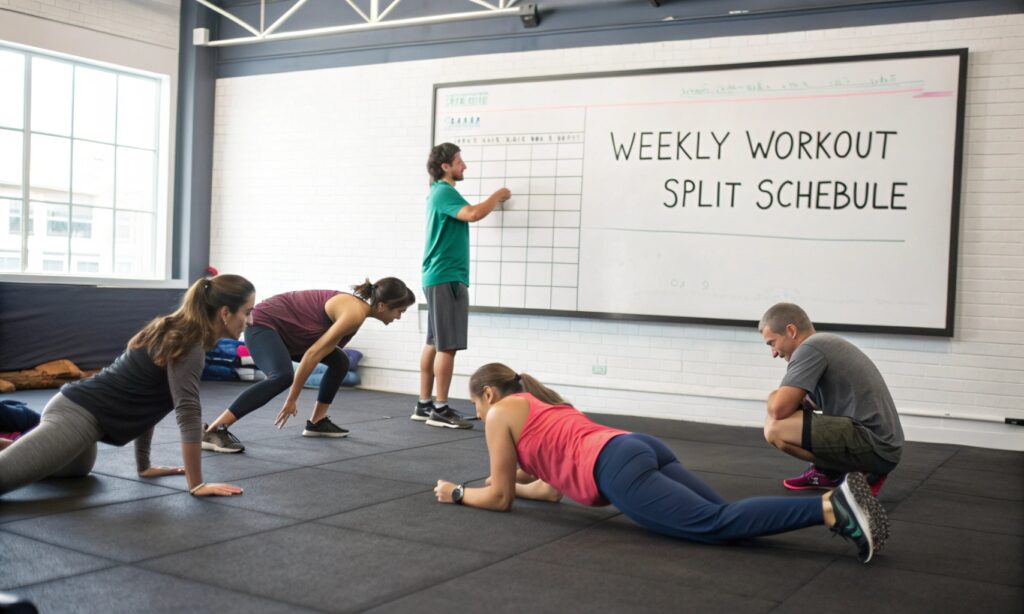Introduction
Achieving a sculpted, athletic physique doesn’t have to be a mystery. Get Toned and Lean: The Best Exercises for Building Muscle and Burning Fat is a comprehensive guide that blends science‑based training principles with practical tips, helping you transform stubborn body‑fat into lean muscle. Whether you’re a beginner or a seasoned gym‑goer, this roadmap will equip you with the exact moves, sets, and recovery strategies needed to see real results fast.
In this article you’ll learn why combining resistance training with high‑intensity cardio is the gold standard for fat loss, how to structure workouts for optimal hypertrophy, and which nutrition tweaks amplify every rep you lift. Let’s dive into the proven workout formulas that make getting toned and lean not just possible, but inevitable.
Why Compound Movements Dominate the “Get Toned and Lean” Playbook
Compound exercises such as squats, deadlifts, bench presses, and pull‑ups engage multiple muscle groups simultaneously, demanding more oxygen and energy than isolation moves. This heightened metabolic demand translates into greater caloric burn during the session and a larger afterburn effect—known as excess post‑exercise oxygen consumption (EPOC). When you Get Toned and Lean, maximizing EPOC is essential because it keeps your metabolism revved up for hours after you leave the gym.
Beyond calorie expenditure, compound lifts stimulate the release of anabolic hormones like testosterone and growth hormone, which are critical for muscle hypertrophy. More muscle tissue means a higher resting metabolic rate, creating a virtuous cycle: more muscle → more calories burned at rest → easier fat loss. By anchoring your routine around these powerhouse lifts, you guarantee a solid foundation for both muscle growth and fat burning.
Key Compound Exercises to Prioritize
-
- Squat Variations – Back, front, goblet, and Bulgarian split squats.
-
- Deadlift Variations – Conventional, sumo, Romanian, and trap bar.
-
- Press Variations – Bench press, overhead press, and dumbbell presses.
-
- Pulling Movements – Pull‑ups, chin‑ups, rows, and lat pulldowns.
Programming Tips
Aim for 3–4 compound‑focused sessions per week, using a rep range of 6‑12 for hypertrophy, while keeping the rest periods between 60‑90 seconds to preserve a high heart rate.
High‑Intensity Interval Training (HIIT) – The Fat‑Blasting Engine
HIIT is the perfect complement to heavy lifting when you Get Toned and Lean. By alternating short bursts of maximal effort (20‑45 seconds) with brief recovery periods, HIIT pushes your cardiovascular system to its limits, dramatically increasing both aerobic and anaerobic capacity. Research consistently shows that HIIT can burn 2‑3 times more calories than steady‑state cardio in the same timeframe, making it ideal for those with limited training windows.
Because HIIT taps into fast‑twitch muscle fibers, it also promotes muscle preservation—a common concern when dieting for fat loss. When paired with strength training, HIIT helps maintain lean tissue while shredding unwanted fat. The secret lies in selecting modalities that also engage large muscle groups, such as sprint intervals, rowing sprints, or kettlebell swings, ensuring every second counts toward a leaner physique.
A typical HIIT session might look like this: 5‑minute warm‑up, 8 rounds of 30‑seconds all‑out effort followed by 30‑seconds rest, then a 5‑minute cool‑down. This 20‑minute protocol can be performed 2–3 times per week, ideally on non‑lifting days or after a shorter strength session to avoid excessive fatigue.
Best HIIT Modalities for Lean Muscle
-
- Bike sprints (30 seconds on, 30 seconds off)
-
- Rowing machine intervals
-
- Burpee ladders
-
- Kettlebell swings (35‑40 lbs)
Strategic Split Routines: Balancing Volume, Frequency, and Recovery

When you aim to Get Toned and Lean, the way you split your weekly training matters as much as the exercises themselves. A well‑designed split allows you to hit each muscle group with enough volume for growth while providing sufficient recovery to prevent overtraining—a key factor in keeping cortisol low and testosterone high.
Two of the most effective splits for simultaneous muscle gain and fat loss are the Upper/Lower split and the Push/Pull/Legs (PPL) split. The Upper/Lower split lets you train each major muscle group twice per week with moderate volume, perfect for intermediate lifters. In contrast, the PPL split offers a higher frequency (up to six sessions weekly) with focused muscle groups, ideal for advanced trainees who can tolerate increased volume.
Regardless of the split you choose, ensure each workout contains at least one compound movement, 1‑2 isolation accessories for shape, and a finisher that spikes the heart rate (e.g., a short HIIT circuit). This hybrid approach guarantees both hypertrophic stimulus and caloric burn.
Sample Upper/Lower Split (4 Days/Week)
Day 1 – Upper Body: Bench press, bent‑over rows, overhead press, pull‑ups, triceps extensions, biceps curls.
Day 2 – Lower Body: Back squat, Romanian deadlift, lunges, leg curls, calf raises.
Day 3 – Rest or Light HIIT
Day 4 – Upper Body: Incline dumbbell press, T‑bar rows, lateral raises, chin‑ups, skull crushers, hammer curls.
Day 5 – Lower Body: Front squat, sumo deadlift, Bulgarian split squat, leg press, seated calf raise.
Key Programming Variables
Target 10‑12 sets per major muscle group per week, keep reps in the 8‑12 range for hypertrophy, and manipulate intensity (load) each week using a linear or undulating periodization model.
Nutrition Tactics That Accelerate Muscle Growth While Cutting Fat
Even the most sophisticated workout plan stalls without proper nutrition. To truly Get Toned and Lean, you must hit a modest caloric deficit while still providing enough protein and micronutrients to support muscle repair. The sweet spot is a 10‑15% deficit from maintenance calories, paired with a protein intake of 1.6‑2.2 g per kilogram of body weight daily.
Carbohydrates play a pivotal role in fueling high‑intensity sessions such as HIIT and heavy lifts. Timing carbs around your workouts—consuming a 30‑40 g serving 30‑60 minutes pre‑training and replenishing with a similar amount post‑training—preserves glycogen stores, sustains performance, and improves recovery. Fats should comprise roughly 20‑30% of total calories, focusing on omega‑3 rich sources that help manage inflammation and support hormonal health.
Micronutrients, especially magnesium, zinc, and vitamin D, are often overlooked yet crucial for muscle function and testosterone production. Incorporate leafy greens, nuts, seeds, and sunlight exposure (or a supplement) to prevent deficiencies that could sabotage your lean‑building goals.
Sample Daily Macro Breakdown (for a 75 kg individual)
-
- Calories: 2,200 kcal (≈10% deficit)
-
- Protein: 150 g (600 kcal)
-
- Carbohydrates: 220 g (880 kcal)
-
- Fats: 73 g (660 kcal)
Meal Timing Tips
Pre‑Workout: 20‑30 g fast‑digesting carbs + 15‑20 g whey protein.
Post‑Workout: 30‑40 g carbs + 25‑30 g protein within 45 minutes.
Before Bed: Casein or Greek yogurt for slow‑release protein.
Recovery Strategies: Sleep, Mobility, and Stress Management for Lean Gains
Recovery is the invisible pillar that determines whether you truly Get Toned and Lean. Without adequate sleep, the body’s anabolic signaling drops, cortisol spikes, and muscle‑protein synthesis stalls. Aim for 7‑9 hours of uninterrupted sleep per night; consider a short 20‑minute nap on intensive training days to further boost recovery hormones.
Mobility work and active recovery sessions safeguard joint health and prevent the stiffness that often follows high‑frequency training. Incorporating 10‑15 minutes of dynamic stretching before lifts and static stretching or foam‑rolling after workouts can enhance range of motion, improve muscle elasticity, and reduce injury risk—keeping you consistent over the long term.
Stress management outside the gym is equally vital. Chronic psychological stress elevates cortisol, which can promote fat storage, especially around the abdomen. Techniques like mindfulness meditation, deep‑breathing exercises, or simply engaging in hobbies you love can lower stress hormones, allowing your body to stay in an anabolic state conducive to muscle building and fat loss.
Practical Recovery Checklist
-
- Track sleep quantity and quality with a wearable or app.
-
- Schedule at least one full rest day per week.
-
- Perform a 5‑minute mobility circuit (hip circles, shoulder pass‑throughs) before each session.
-
- Use foam‑rolling for 2‑3 minutes per major muscle group post‑workout.
-
- Practice 5‑10 minutes of breathing meditation before bed.
Final Thought
Getting toned and lean isn’t a quick fix; it’s a disciplined blend of smart training, precise nutrition, and diligent recovery. By integrating the compound‑centric strength routine, HIIT cardio, strategic split programming, nutrition that fuels performance while creating a slight deficit, and recovery habits that keep hormones optimal, you set yourself up for sustainable, visible transformation. Start implementing these principles today, track your progress, and watch your body evolve into the muscular, lean version you’ve always wanted.



